Home
Bill Erickson and the path to the LWA
Bill Erickson was born about a year before Karl Jansky discovered cosmic radio waves in 1931 and ushered in the birth of radio astronomy. Jansky's antenna, pictured here, was designed to receive radio waves at a frequency of 20.5 MHz, near the lower end of the LWA frequency range.
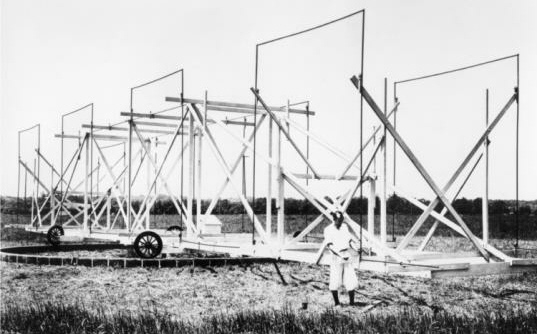
ASP Conference Series V345 includes, in addition to papers of the early stages of the LWA project, a copy of one of Jansky's now famous early publications, together with reproductions of several other historical papers from the birth of radio astronomy at low frequencies.
The History of the Clark Lake Observatory
In the late 1950s, Convair Scientific Research Lab created CSRL in San Diego. Bill Erickson, former student of Director Critchfield, was hired to begin work at Clark Lake in the Anza Borrego desert in southern California. By the early 1960s, Convair transferred what became the Clark Lake Radio Observatory (CLRO) to the University of Maryland under Professor Bill Erickson.
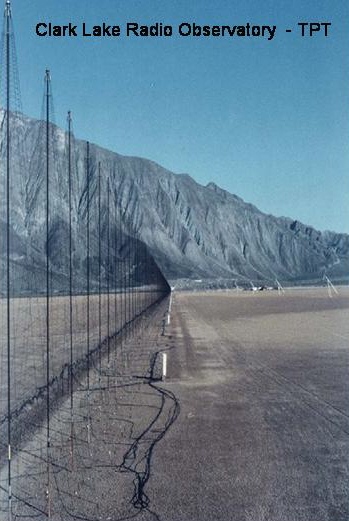 The Clark Lake Teepee-Tee Telescope pictured at right, was the last in a succession of innovative instruments developed in the 1970s by Bill Erickson and his students (Polisensky & Kassim 2005). The ~3 km TPT was a a broad-band (10-123 MHz), fully electronic, fast and versatile instrument that will only be surpassed in capability and sophistication by the emerging much larger (>100 km) instruments such as the LWA.
The Clark Lake Teepee-Tee Telescope pictured at right, was the last in a succession of innovative instruments developed in the 1970s by Bill Erickson and his students (Polisensky & Kassim 2005). The ~3 km TPT was a a broad-band (10-123 MHz), fully electronic, fast and versatile instrument that will only be surpassed in capability and sophistication by the emerging much larger (>100 km) instruments such as the LWA.
The 74 MHz system on the Very Large Array
One of the first proposals to extend earlier techniques to frequencies below 100 MHz with a connected element, synthesis imaging array was made shortly after self-calibration was first introduced, when Rick Perley and Bill Erickson proposed development of a large, dipole-based array to work alongside the VLA in New Mexico. (G. Swarup's original concept for the GMRT also appeared at about this time.) Funding to implement the sensitive, broad-band, ambitious system originally envisaged in VLA Technical Memorandum #146 (Perley and Erickson 1984 - reproduced as LWA Memo #1 was not readily available at that time. However, their proposal inspired the Naval Research Laboratory (NRL) and National Radio Astronomy Observatory (NRAO) to work together in the early 1990s to implement a narrow-band, modest version of the Perley-Erickson proposal using the existing VLA dishes and infrastructure.
The 74 MHz System on the Very Large Array with 74 MHz receivers on all 27 VLA antennas, became operational in 1998. It attracted a wide variety of scientific projects in the areas of solar system (planetary emission, solar bursts), Galactic (supernova remnants, ISM), and extragalactic (clusters, radio galaxies) astrophysics. A major project is the VLA Low Frequency Sky survey (VLSS) a 74 MHz complement to the successful NVSS 20 cm VLA sky survey. See The NRL-NRAO 74 MHz VLA for further details.
The Bruny Island Radio Spectrometer (BIRS)
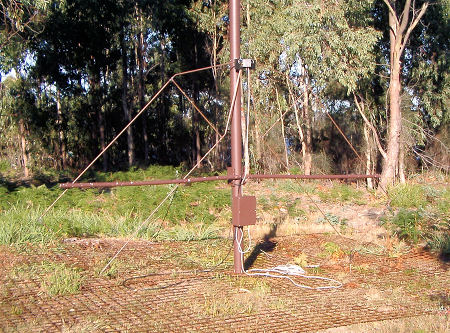 Bruny Island lies off the south-eastern corner of Tasmania, Australia. Since 1 January 1998 low frequency solar radio burst observations have been made daily with the Bruny Island Radio Spectrometer (BIRS) developed by Bill Erickson. Since 15 September 2006, the solar burst data appear on the Green Bank Solar Radio Burst Spectrometer website . Earlier data were on a University of Tasmania web site and can be made available by contacting Bill Erickson.
Bruny Island lies off the south-eastern corner of Tasmania, Australia. Since 1 January 1998 low frequency solar radio burst observations have been made daily with the Bruny Island Radio Spectrometer (BIRS) developed by Bill Erickson. Since 15 September 2006, the solar burst data appear on the Green Bank Solar Radio Burst Spectrometer website . Earlier data were on a University of Tasmania web site and can be made available by contacting Bill Erickson.
The frequency range of the observations is from the low frequency ionospheric cutoff to 62.5 MHz. The ionospheric cutoff occurs at a frequency at which radio waves from the Sun no longer penetrate the Earth's ionosphere and is normally between 7 MHz and 12 MHz: it is a strong function of the local elevation of the Sun. Only the 12 to 62 MHZ frequency range is normally displayed on the website.
The solar emissions are received with the wide-band, droopy, active dipole shown in the accompanying photo above. This antenna may be considered one of the first bona fide LWA prototype antennas!
The Grote Reber Medal
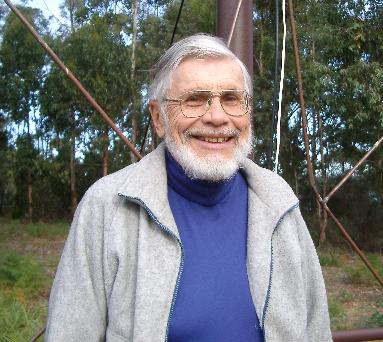 In 2005, the Inaugural Grote Reber Medal was awarded to Bill Erickson, Professor Emeritus at University of Maryland and Honorary Research Associate at the University of Tasmania. Professor Erickson was recognized for his innovative contributions to radio astronomy, especially for his many novel techniques which have been the forerunner of the new generation of metre-wavelength radio telescopes. Currently he operates his own private radio observatory on Bruny Island in Tasmania. (Photo from the cited website article.)
In 2005, the Inaugural Grote Reber Medal was awarded to Bill Erickson, Professor Emeritus at University of Maryland and Honorary Research Associate at the University of Tasmania. Professor Erickson was recognized for his innovative contributions to radio astronomy, especially for his many novel techniques which have been the forerunner of the new generation of metre-wavelength radio telescopes. Currently he operates his own private radio observatory on Bruny Island in Tasmania. (Photo from the cited website article.)
The Long Wavelength Array (LWA)
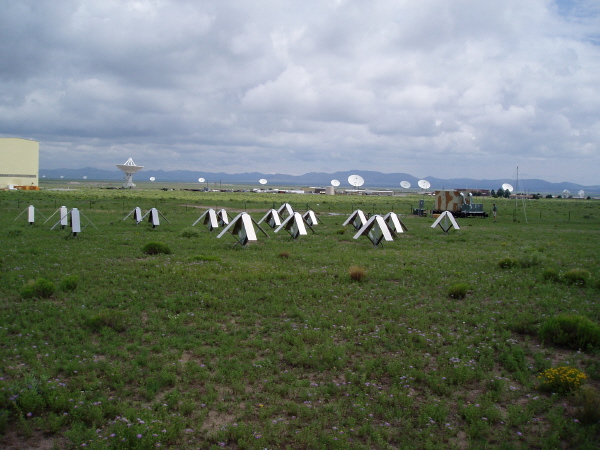 The photo at the left was taken in August 2006.
The photo at the left was taken in August 2006.
It shows the 16 dipoles of the
Long Wavelength Demonstrator Array (LWDA)
which is located on the site of the Very Large Array
seen in the background. The LWDA serves as an
initial technical test bed for the LWA, the project
inspired by Bill Erickson's historical legacy. Bill's
valuable scientific and technical guidance remain one of the key assets of the project today.